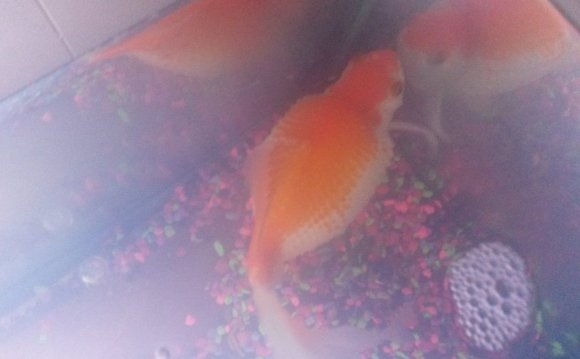
 Photo © R. Hunt
Photo © R. Hunt
Constipation, although terribly embarrassing, is a very common Betta ailment. Constipation is normally caused by the Betta being fed too many rich foods (such as bloodworms) and not enough fiber. Constipation can also become a recurring problem in elderly Bettas (sort of like people!).
Constipation is fairly easy to diagnose if you know what to look for. The most obvious sign that a Betta is constipated is the lack of any bowel movements, or very small bowel movements that don't match up to the amount of food the Betta has been eating. Since it can be quite difficult to catch a Betta in "the act, " it may be necessary to diagnose constipation from secondary symptoms. These can include: a swollen tummy (the area right behind the ventral fins and right in front of the anal fin), loss of appetite (although some Bettas are such pigs that they will eat until they explode, it's a good indicator but not necessarily accurate), and, in later stages, fading color. Constipation will often go hand in hand with Swim Bladder Disease, as the intestinal blockages caused by being constipated can interfere with the operation of the swim bladder. If your Betta is showing Swim Bladder Disease-like symptoms, often the first thing to do is to make sure he's not constipated.
ConstipationTreatment
The upside is that constipation is generally very easy to diagnose and treat, the downside is that, if left untreated, constipation can easily lead to death.
The first thing to do if constipation is suspected is to isolate the Betta if he isn't already. The reason you want to Isolate the Betta is not because constipation is contagious (it isn't), it's because you want to be able to monitor his food intake and feces output. Before treatment begins, give him a nice water change. It is also helpful to leave the container bare-bottomed as it allows you to watch for any fecal matter he may be passing. If the Betta is showing signs of Swim Bladder Disease as well, you may want to leave the water level fairly low (4-5") so that he doesn't have to struggle to the top for air. Right, on to treatment.
Number one, stop feeding him. I know he looks pathetic and he thinks he's starving to death, but Bettas can live for a very long time without food and it's dangerous to just let the food keep backing up inside him with no way to escape. The first remedy I like to try with constipated bettas is called "the Pea Trick." Take a frozen or fresh pea (you can used canned peas if you don't have access to fresh or frozen, but they do contain a lot of salt and the others are really preferable), and cook it until it's squishy. Peel the skin away, and break the "meat" into small, Betta-bite-size pieces. Do your best to tempt your Betta into eating some of them - tips on doing this include:
Drag your finger over the water surface to evoke their hunting instincts, and then drop the pea bit in one at a time.
Poke the pea bits onto the end of a toothpick and move it about like it's live food (be careful you don't poke the betta if you use this method).
Basically do anything you can to get that Betta interested in the pea.
Make sure you remove any pea bits that don't get eaten so they don't dissolve and foul the water (icky water = bad). Hopefully your Betta was interested in the pea, if he ate some of it just sit back and watch for a bowel movement in the next day or so. You can repeat "the Pea Trick" as often as he'll consume them (just don't go overboard with it).
If you can't get him to eat any pea or he doesn't seem to be passing anything after eating it, you can give an Epsom salt bath a shot. You may have noticed that I didn't advocate adding aquarium/rock salt this time, and there's a reason for this. Regular salt will cause fish to absorb more water. When you've got a bloated fish, you want them to excrete, not absorb. Epsom salt will get this done for you.
Setting up an Epsom Salt bath:
Add 1 Tbsp per gallon of Epsom Salt to some aged, temperature-adjusted (same temperature as the water the betta is already in) water.
Pour Epsom Salt solution into a containter.
Place the Betta in the Epsom Salt bath for 15-20 minutes. While the Betta is having a bath, change the water in his tank so that he has nice, clean water to go back to afterwards. Make SURE that the water in all of these containers is the same temperature, we don't need the Betta getting another disease right now.
Hopefully the Epsom Salt bath will help to loosen the blockage, just sit back and watch. The Epsom Salt bath can be repeated up to two times a day - just be aware that it is stressful to the fish, so if you can get him to eat the pea, give the pea a shot first.









